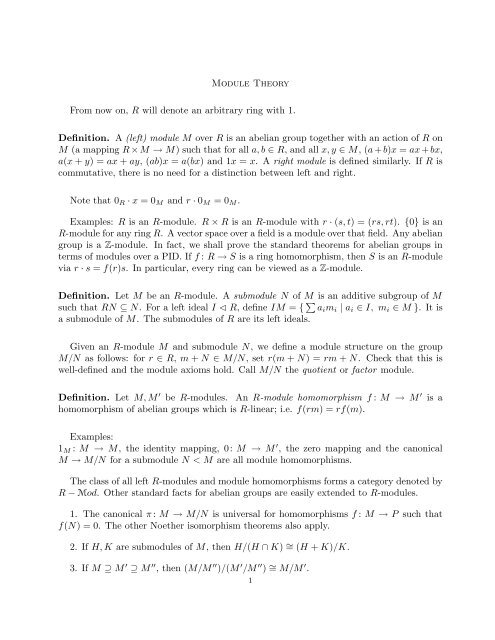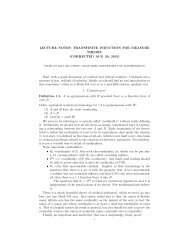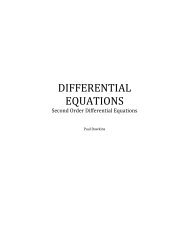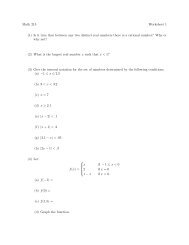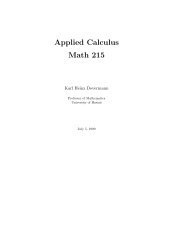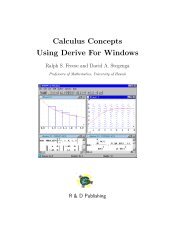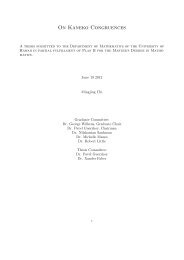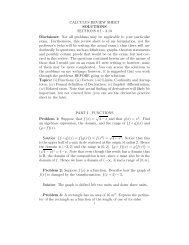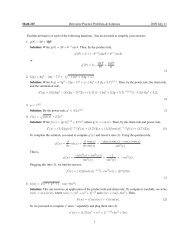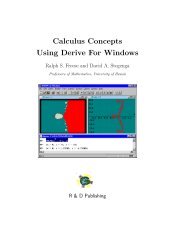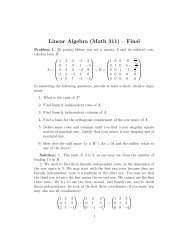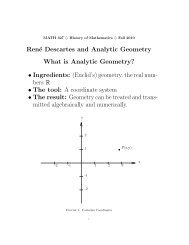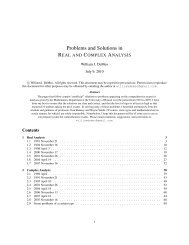Module Theory From now on, R will denote an arbitrary ring with 1 ...
Module Theory From now on, R will denote an arbitrary ring with 1 ...
Module Theory From now on, R will denote an arbitrary ring with 1 ...
Create successful ePaper yourself
Turn your PDF publications into a flip-book with our unique Google optimized e-Paper software.
<str<strong>on</strong>g>Module</str<strong>on</strong>g> <str<strong>on</strong>g>Theory</str<strong>on</strong>g><br />
<str<strong>on</strong>g>From</str<strong>on</strong>g> <str<strong>on</strong>g>now</str<strong>on</strong>g> <strong>on</strong>, R <strong>will</strong> <strong>denote</strong> <strong>an</strong> <strong>arbitrary</strong> <strong>ring</strong> <strong>with</strong> 1.<br />
Definiti<strong>on</strong>. A (left) module M over R is <strong>an</strong> abeli<strong>an</strong> group together <strong>with</strong> <strong>an</strong> acti<strong>on</strong> of R <strong>on</strong><br />
M (a mapping R × M → M) such that for all a, b ∈ R, <strong>an</strong>dallx, y ∈ M, (a+b)x=ax + bx,<br />
a(x + y) =ax + ay, (ab)x = a(bx) <strong>an</strong>d1x=x.Aright module is defined similarly. If R is<br />
commutative, there is no need for a distincti<strong>on</strong> between left <strong>an</strong>d right.<br />
Note that 0R · x =0M <strong>an</strong>d r · 0M =0M.<br />
Examples: R is <strong>an</strong> R-module. R × R is <strong>an</strong> R-module <strong>with</strong> r · (s, t) =(rs, rt). {0} is <strong>an</strong><br />
R-module for <strong>an</strong>y <strong>ring</strong> R. A vector space over a field is a module over that field. Any abeli<strong>an</strong><br />
group is a Z-module. In fact, we shall prove the st<strong>an</strong>dard theorems for abeli<strong>an</strong> groups in<br />
terms of modules over a PID. If f : R → S is a <strong>ring</strong> homomorphism, then S is <strong>an</strong> R-module<br />
via r · s = f(r)s. Inparticular,every<strong>ring</strong>c<strong>an</strong>beviewedasaZ-module.<br />
Definiti<strong>on</strong>. Let M be <strong>an</strong> R-module. A submodule N of M is <strong>an</strong> additive subgroup of M<br />
such that RN ⊆ N. For a left ideal I ⊳ R, define IM = { aimi | ai ∈ I, mi ∈ M }. Itis<br />
a submodule of M. The submodules of R are its left ideals.<br />
Given <strong>an</strong> R-module M <strong>an</strong>d submodule N, we define a module structure <strong>on</strong> the group<br />
M/N as follows: for r ∈ R, m + N ∈ M/N, set r(m + N) =rm + N. Check that this is<br />
well-defined <strong>an</strong>d the module axioms hold. Call M/N the quotient or factor module.<br />
Definiti<strong>on</strong>. Let M,M ′ be R-modules. An R-module homomorphism f : M → M ′ is a<br />
homomorphism of abeli<strong>an</strong> groups which is R-linear; i.e. f(rm) =rf(m).<br />
Examples:<br />
1M : M → M, the identity mapping, 0: M → M ′ , the zero mapping <strong>an</strong>d the c<strong>an</strong><strong>on</strong>ical<br />
M → M/N for a submodule N
2<br />
4. Submodules of M/N corresp<strong>on</strong>d to submodules of M c<strong>on</strong>taining N.<br />
Theorem. In the category of R-modules, direct products <strong>an</strong>d direct sums (coproducts) exist.<br />
For <strong>an</strong>y subset S of <strong>an</strong> R-module M, the set N = { n<br />
1 risi | ri ∈ R, si ∈ S } is<br />
the submodule of N generated by S. M is finitely generated if it has a finite number of<br />
generators. For m ∈ M, Rm is a principal submodule of M.<br />
Propositi<strong>on</strong>. Let M be <strong>an</strong> R-module, N1,N2 submodules of M. M ∼ = N1 ⊕ N2 iff M =<br />
N1 + N2 <strong>an</strong>d N1 ∩ N2 = {0}.<br />
Theorem. Let I be <strong>an</strong>y set. The free R-module <strong>on</strong> the set I is the coproduct R (I) .<br />
Definiti<strong>on</strong>. Let M be <strong>an</strong> R-module. A subset S ⊆ M is a basis for M if every element of<br />
M c<strong>an</strong> be written uniquely as a linear combinati<strong>on</strong> of elements of S.<br />
Remarks. The free modules are the modules that have bases. Direct sums of free modules<br />
are free since R (I) ⊕ R (J) ∼ = R I ˙∪J) . The zero module (0) is the free module <strong>on</strong> the empty<br />
set.<br />
Example. The free abeli<strong>an</strong> groups are the groups of the form Z (I) <br />
. If |I| = n,wehave<br />
n<br />
i=1 Z is the free abeli<strong>an</strong> group <strong>on</strong> n generators. The Z-module Z/mZ is thus <strong>an</strong> abeli<strong>an</strong><br />
group which is not free.<br />
Propositi<strong>on</strong>. Every module c<strong>an</strong> be written as the quotient of a free module.<br />
Characterizati<strong>on</strong> of finitely generated modules over a PID.<br />
Theorem. Let R be a PID, F a finitely generated free module over R <strong>an</strong>d M a submodule<br />
of F . Then M is free <strong>with</strong> the number of generators less th<strong>an</strong> or equal to the number of<br />
generators of F . (This is true <strong>with</strong>out the hypothesis of finitely generated [L, Theorem<br />
III.7.1].)<br />
Invari<strong>an</strong>t Basis Property. Any two bases of F have the same number of elements.<br />
The theorem fails for principal ideal <strong>ring</strong>s (not domains): take R = Z/6Z <strong>an</strong>d M =<br />
{0, 2, 4}. The theorem fails for UFD’s: take R = R[x, y] <strong>an</strong>dM=theideal(x, y).
Propositi<strong>on</strong>. Let R be a commutative <strong>ring</strong> <strong>an</strong>d F a finitely generated free module. Given a<br />
basis {e1,...,en}, <strong>an</strong>d elements fi = n j=1 aijej, theset{f1,...,fn} is a basis iff det(aij)<br />
is <strong>an</strong> invertible element of R.<br />
Lemma. Let R be a PID, a1,...<strong>an</strong> ∈R, d=gcd(a1,...<strong>an</strong>).Then(a1,...<strong>an</strong>)=(d).<br />
Theorem. Let R be a PID <strong>an</strong>d F = Re1 ⊕···⊕Ren be free. Let f = n<br />
i=1 aiei ∈ F .Then<br />
fis part of a basis iff gcd(a1,...<strong>an</strong>)=1.<br />
Corollary. f is part of a basis iff there exists a module homomorphism φ: F → R such<br />
that φ(f) =1.<br />
Stacked Basis Theorem. Let F be a finitely generated free module over a PID R <strong>an</strong>d<br />
M
4<br />
p1,...pk <strong>an</strong>d positive integers e1,...,ek <strong>an</strong>d <strong>an</strong> integer n ≥ 0 such that G is isomorphic to<br />
⊕Zn .<br />
Z p e 1<br />
1 ⊕···⊕Z p e k<br />
k<br />
If n =0,thenGis finite. If k =0,thenGis free. In particular, every finitely generated<br />
abeli<strong>an</strong> group is a direct sum of cyclic groups.<br />
Noetheri<strong>an</strong>, Artini<strong>an</strong> modules <strong>an</strong>d the Jord<strong>an</strong>-Hölder Theorem.<br />
For this secti<strong>on</strong>, R is <strong>an</strong>y <strong>ring</strong> <strong>with</strong> 1.<br />
Theorem. Let M be a left R-module. The following are equivalent:<br />
(1) All submodules of M are finitely generated.<br />
(2) (ACC) Given <strong>an</strong>y sequence of submodules N1 ⊆ N2 ⊆···, it must eventually become<br />
c<strong>on</strong>st<strong>an</strong>t.<br />
(3) Any n<strong>on</strong>empty collecti<strong>on</strong> of submodules has a maximal element.<br />
<str<strong>on</strong>g>Module</str<strong>on</strong>g>s satisfying the c<strong>on</strong>diti<strong>on</strong>s of the previous theorem are called Noetheri<strong>an</strong>. If all<br />
left ideals of R are finitely generated, then R is a left Noetheri<strong>an</strong> <strong>ring</strong>.<br />
A module is called Artini<strong>an</strong> if the following hold<br />
(1) (DCC) Every descending chain of submodules eventually becomes c<strong>on</strong>st<strong>an</strong>t.<br />
(2) Every collecti<strong>on</strong> of submodules has a minimal element.<br />
These two c<strong>on</strong>diti<strong>on</strong>s are equivalent by <strong>an</strong> <strong>an</strong>alogous proof to that in the Noetheri<strong>an</strong> case.<br />
Theorem. Let N
Definiti<strong>on</strong>. A compositi<strong>on</strong> series for <strong>an</strong> R-module M is a finite sequence of submodules<br />
0=N0 ⊆N1 ⊆···⊆Ns =M such that each quotient Ni/Ni−1 is simple. Call s the length<br />
of the compositi<strong>on</strong> series <strong>an</strong>d Ni/Ni−1 the compositi<strong>on</strong> factors. We say M has finite length<br />
if it has a compositi<strong>on</strong> series.<br />
Theorem. M has finite length iff M satisfies both ACC <strong>an</strong>d DCC.<br />
Our proof of the Jord<strong>an</strong>-Hölder Theorem for groups carries over (but is easier as we d<strong>on</strong>’t<br />
have to worry about normality) to this setting.<br />
Jord<strong>an</strong>-Hölder Theorem. Let M be <strong>an</strong> R-module <strong>with</strong> a compositi<strong>on</strong> series of length s.<br />
Then all compositi<strong>on</strong> series for M have length s <strong>an</strong>d the compositi<strong>on</strong> factors are the same<br />
(up to permutati<strong>on</strong> <strong>an</strong>d isomorphism).<br />
References<br />
[J2] N. Jacobs<strong>on</strong>, Basic Algebra II, W. H. Freem<strong>an</strong> <strong>an</strong>d Co., 1980.<br />
[L] S. L<strong>an</strong>g, Algebra, 3rd ed., Addis<strong>on</strong>-Wesley, 1993.<br />
[S] M. Steinberger, Algebra, PWS Publishing Co., Bost<strong>on</strong>, 1994.<br />
5


